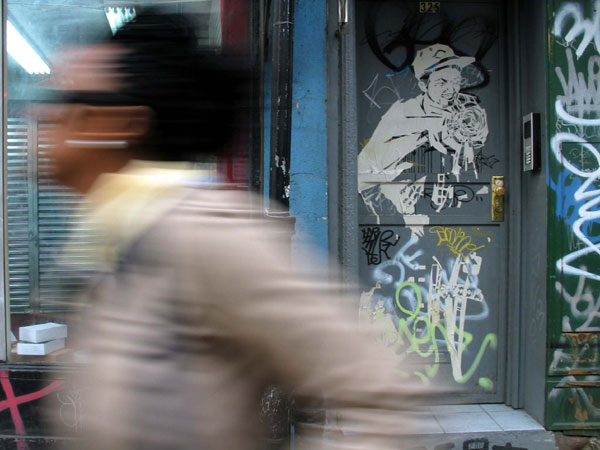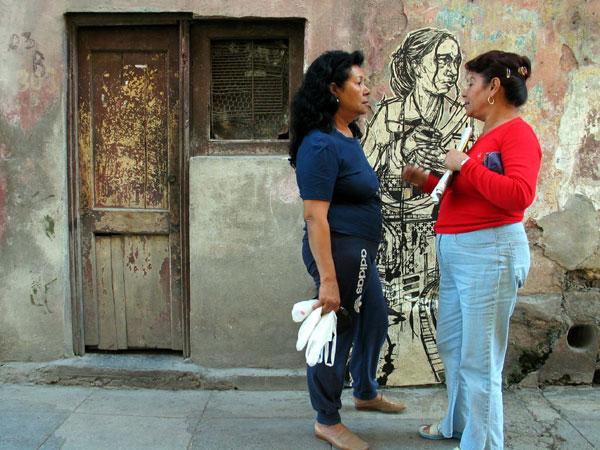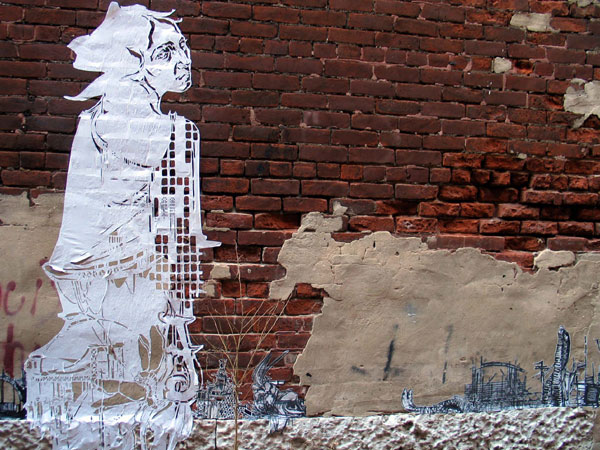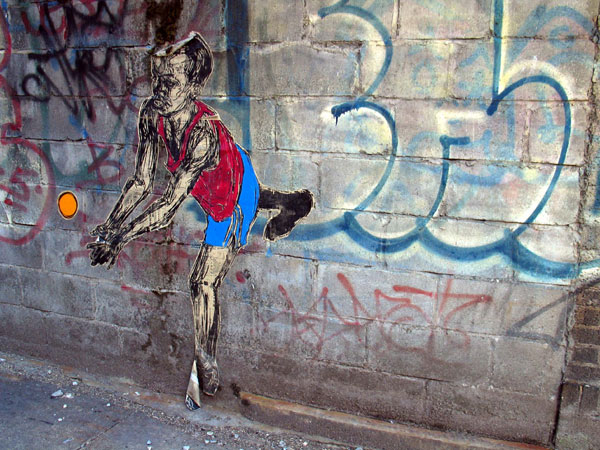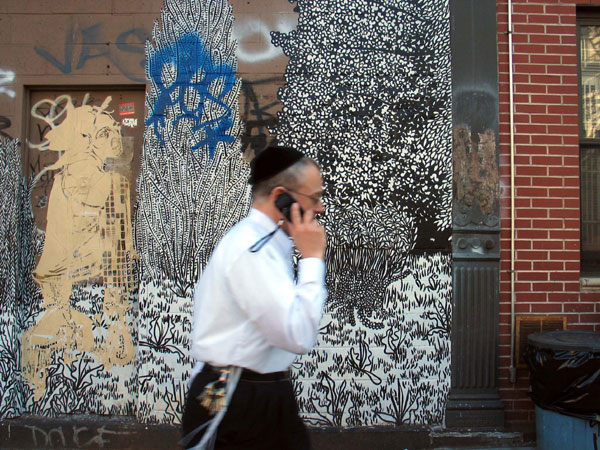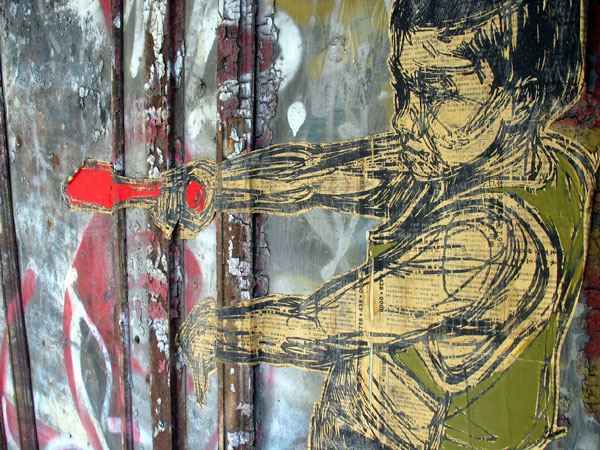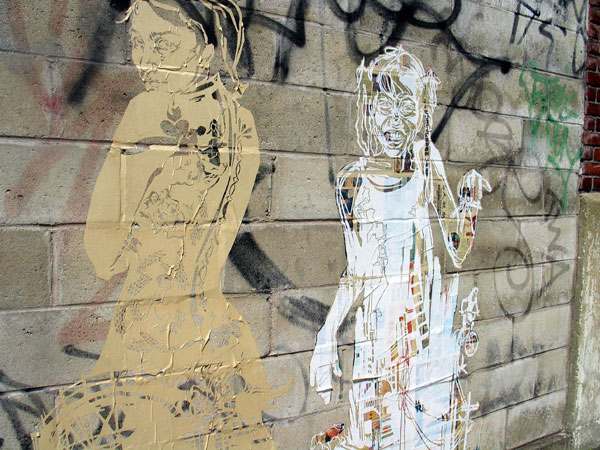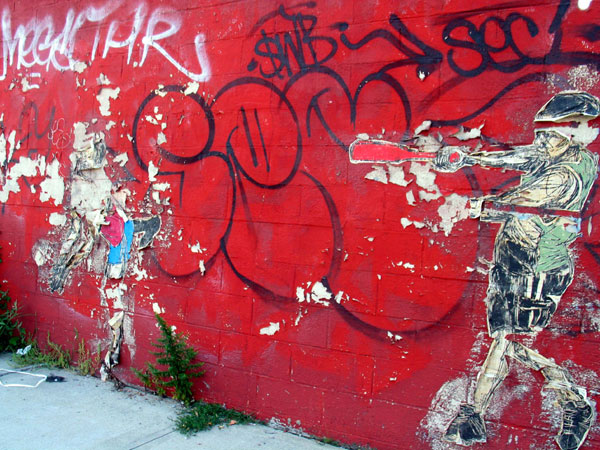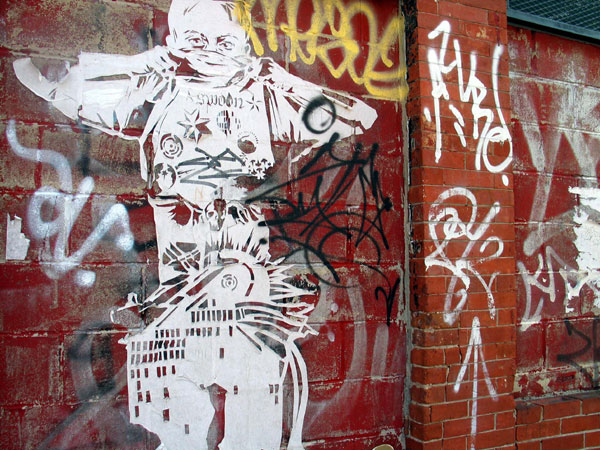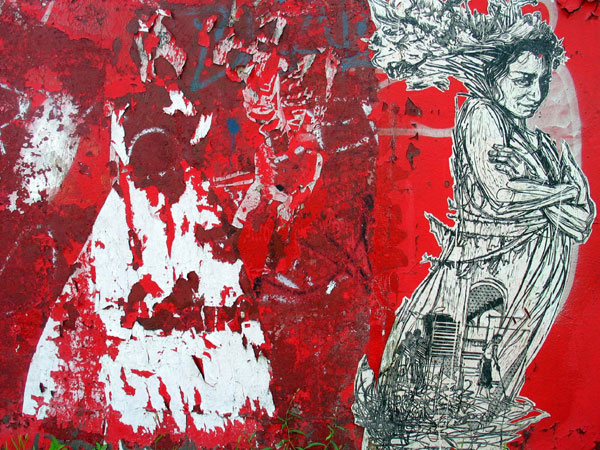If you live in New York, you probably have passed by Swoon’s work. Her cutouts and block prints decorate walls all over the city, remaining until they flake away or simply rot. She lets the weather wear down her work, even though making most pieces takes hours, not to mention meticulous attention, detail, and even pain, because years of carving have exacted a toll on her hands. The paste that keeps her work on walls loses its strength. The printed or cutout faces yellow and then fall apart. The arm of a woman decays into ribbons.
Her subjects are almost always people, chosen from the burble of the streets. She singles out those characters who give cities their visual slang, but who often are taken for granted as part of the everyday fauna. A kid riding on a low-riding bicycle may go unnoticed. A man sitting on a milk crate doesn’t attract attention. Swoon retrieves them, for a moment, from the blur of the city. The boy on the bike takes a bow as one of the city’s many essential cast members.
I sat down with Swoon at a café in Fort Greene, Brooklyn.
Pitchaya Sudbanthad: Some of your hand-pulled prints and cutouts take up to two weeks to make, and then you post them outside, exposed to wind, rain, and sun. There’s something very Buddhist about that process, which makes me think of intricate sand mandalas that Tibetan monks make and then wipe away with a broom. Can you talk more about that will of decay?
Swoon: One thing I have to say is that I’m not as pure in that way as you might think. With the prints, I have print blocks I keep that I can work from again and make multiples. So, in a way, the images can be thought of as permanent.
Anyway, when I first began to do street work, part of my impulse had to do with those things that are meant to disappear and the ability to just let things go. The first things I looked at were the sand mandalas and Gordon Matta-Clark, an artist who was chopping up buildings in the ‘70s, and each one of his sculptures was made out of buildings that were already slated for demolition. He knew the buildings were going to be destroyed and that only a certain number of people would see his work, but that was an integral part of what he was doing. Something about the immediacy of his art and the ability to create something that was really specific and relevant to its time felt good to me. We’re taught in school to be so precious and meticulous and archival and to make every little decision last. I wanted to make things that were valueless, because they couldn’t belong to any one person, and in that way they would belong to everyone. I liked the idea of things that weren’t going to stick around and that were like an event more than an object.
PS: The idea very much persists in the materials that you use. They tend to be purposefully fragile. What kinds of paper have you been working with?
S: I use recycled newsprint that I order in 90-pound rolls. So it’s extremely thin and is one of my favorite papers to use because of the way it decays. It yellows. It cracks. It has this whole life cycle that I really like. I also use other materials. I use tracing paper for the wall beneath the print to show through. I use painting tarps. I also use actual, found newspapers. I like the idea of collecting things that were part of the environment and then recycling them back into that environment. Mostly the found material has more to do with information, like I’d just watch, draw, and take hundreds of photographs, and try to absorb an environment and then reflect it back.
PS: It’s not just the environment. Specifically, you like people. Your pictures are mostly portraits.
S: I started out by doing portraits of people really close to me. The first cutout I did was a portrait of my grandfather. I’ve drawn my little brothers and I’ve drawn my friends, and then I looked around me and chose the subjects. I drew the guy who sells fruit around my block. I drew a bike delivery guy in the neighborhood. I’ve been walking around the city and watching how people interact with the street and then I tried to capture something of that. You know, kids playing baseball or a woman sitting on a stoop. I’m just trying to look at street life. They’re in the public sphere. They’re the liveliness of the city.
The piece I’m finishing tonight is of construction workers. I had the most fun. I don’t know why it never occurred to me to draw construction workers. Do you know that they’re building cities with their hands? I know it’s almost a dumb realization, but you see all the cranes and machinery and think that there’s some magic to it that you’re not getting. I watched the process for a while and saw that they’re just doing things up in the buildings with their wrenches. I would listen and hear the banging. Tok! Tok! Tok! Cities are still built by these guys who are putting it all together with their hands.
And it’s not just New York. Cuba has informed me a lot and I was only there for 10 days. Everyone in Cuba’s living their whole lives outside, because there’s so little car traffic and there’s such a different pace of life. People were getting their haircuts in the street. People were sewing in the street. Kids played baseball everywhere.
Pretty much every city that I go to, I try to absorb a little bit from each place. I feel like this kind of bug that I used to watch when I was growing up in the South. I haven’t seen it since I was a kid. It would camouflage itself by carrying all these twigs and leaves on its back. I feel like I’m always traveling with my weird little package and leaving a bit behind and taking a bit from wherever I go.
PS: How local do you keep your portraits? Do the characters observed in a particular place return to a wall in that neighborhood as a print?
S: I definitely circulate my prints around. I feel like I’m creating this sort of fantastical city that could be anywhere. I’m not thinking about connecting a work to its location. It’s the belly that’s present in every city. It could be any place.
PS: That’s almost like Italo Calvino’s Invisible Cities. You’re talking about all these different people in all these different, dreamlike places, but all the while, you’re really talking about one all-encompassing city. How does the idea of fiction play a role in your work?
S: With the cutouts, because they have so many holes in them, there’s a way in which they instantly become a part of the environment just by the virtue that the wall on which it’s pasted creates the image. If you put a piece on a white wall, then you wouldn’t even able to see it. The piece of paper is almost like blankness, and the wall creates what you can see. At certain points I have had to ask myself, “Why am I putting it outside? Why, then, am I putting this out on the street? How is this relevant to its context?” I wanted to create a situation where the block suddenly makes more sense with the addition I would make, so I started to more closely watch people and what they were doing outside. And so with my work, I’m sort of making a population of fictitious residents.
I like the idea of fiction, because I do human figures. With the portraits that have a lot of details inside them, there’s a lot of free association. When I was in Cuba, I was really afraid of breaking the laws there, because I had no idea how things were, and so I was always asking people if I can work on their walls, and they usually agreed. Within three seconds, I’d get a crowd. People were asking things. “What are you doing? Who are these people you’re putting on the wall? What do they do? What are they thinking? Are you making a cultural activity? Do you know that everything has to go through the cultural activity board? What stories are here? Everything has a story. What are you trying to tell us?”
People really wanted to know what everything meant and how all these portraits linked together. I usually don’t structure stories beforehand, and to see all these people quickly develop narratives really impressed me.
PS: Can you tell me more about how you create the prints and cutouts?
S: The wood I work with a Dremel, which is a little rotating power tool. The knife was starting to murder my arm. I use a couple of processes. I do linoleum, which I work with a knife, because I can iron it and make it soft. When I use paper for the cutouts, I use a utility knife. Sometimes I do a combination of these things.
I start from the sketches, the photographs and the ideas, and then I’ll choose a material. There’s something particular to the images that make me choose that material. There’s almost a fractal element to the work in that some of the images are a character with a lot of smaller images going on inside of them and others are more self-sufficient, a single gesture that seems so complete that it allows me to not have to add more layers to it. A lot has to do with the limitations of the material. The linoleum you can get so much more detail from. Everything that has more nuances, I use linoleum. The wood is rougher, but a good roughness. The paper is really hard to think about, and so it tends to be simpler. With paper, you’d choose simple subjects because it’s hard to create an expression. The challenge is to make the cutout so that it can get on the wall as a solid unit in two minutes or less. The cutout has its own demands, and you have to be careful, or else it tears apart or it rolls through itself or it gets warped.
PS: I’ve always wondered about how you do those paper cutouts. I used to imagine that you dress up in a ninja outfit and blend into the darkness and then spend hours meticulously cutting and peeling your portraits on the wall.
S: The block prints are more obvious, but with the paper cutouts, people are always like, “How did you do that?” It’s actually not that hard. You just roll it on the wall like a very fragile piece of wallpaper. If you have the wall pasted and you treat it right, you can just lay it out and brush it. You learn. It’s a craft. You figure it out. The times I brought people with me to paste, people always said, “It’s so much easier than I thought.” But I’ve been doing less of it, because it hurts my arm a lot, the cutting with the utility knife, and all that pressure and exactness. When I first did them, people always assumed I used a die-cut, because they thought, “You can’t possibly be doing that.” I like obsessive tasks. In fact, I love them.
PS: You used to be a painter, though, and then you abandoned traditional painting. Why?
S: I think it’s a part of the transformation that you have to go through in order to grow up. I know this is going to sound cheesy, but I felt like I had to find my own voice by abandoning what I learned. I studied classical painting—Renaissance-style painting and portraiture—and then when I got to New York, I no longer felt connected to anything I had thought about art. For at least two years, nothing made sense to me, and everything I did felt aimless and destructive, and then things finally came around. So now when I feel like I’m doing things that make no sense, to me, but I still feel deeply compelled to do them, I take it as a good sign.
PS: How do you feel about galleries?
S: I’ve done some works in galleries recently, and so I’m back and forth on how I feel. When I first got to New York, I walked into these spaces and found them to be supremely lifeless. The works were high and austere in that good-enough-for-the-Citibank-lobby sort of way, but they weren’t something I felt connected to. I’m not saying that nothing good was happening, but that by and large, I felt alienated from what was the art world. The fact that I’m somewhat working in it now shows that I had to come into it on my own terms. I never asked for a show or an exhibition. I do shows from time to time, but things just came to me, because they made sense, like recently, when Glowlab’s Christina Ray asked me to participate in a project that was about mapping the space of the gallery onto the surrounding blocks and working with both in continuum. I guess galleries give me some more options, because, say, it doesn’t rain in there. But for some reason, I couldn’t make art for the sole purpose of exhibiting in these comatoriums. It would feel—and I’m quoting Arundhati Roy—like “polishing firewood.”
PS: For most traditional graffiti artists, spray-paint works are often bold self-proclamations. To a certain degree, this trait has passed on to street artists who use prints, stickers, and posters. You don’t even sign your works often, at least with your later pieces.
S: I sign them real small. When I first started there was more of a graffiti mentality. Lately, I’ve been forgetting about it more and more. I do sign them, but it’s less of me telling you who I am and more of what I’m telling you about the people and the neighborhood.
PS: Still, you have a following. People notice what you do. A lot of street artists have capitalized on that attention to a certain degree, and have crossed over into the more commercial aspects of their practice by lending their art to fashion and other products. How do you feel about that?
S: I try hard to avoid that commercial crossover. In the past, companies have approached me, and I’ve said no. I’ve created things that I want to be independent from labels or commercial activities. I want my work to be an independent expression that isn’t being used to hawk products. I feel like the way the first world is living is the wrong way. There are these cool-hunters who come to me from companies—shoe companies, for example—that are exploiting their labor force and the environment, and I can’t lend cultural credibility to institutions like that. Still, corporate sponsorship is hard to get away from, because so many things are being sponsored. For me, it’s about choosing who or what you’re working for.
PS: At the same time, in both graffiti and street art, there’s a prevalent tendency of repetition. Names appear repeatedly. The same stickers or stencils pop up all over the landscape. In some circles, that could be called branding.
S: I feel like I’m not immune to that, because I have a name and a recognizable work. I like the idea of repetition because I like mutations that can happen from it, but the idea of a logo is not as interesting to me.
PS: You’re also very careful about where you put up your works. They tend to be in places that are ambiguously private and public. They are spaces that are somewhat forgotten, but still exist in the public visual domain. For whom are you reclaiming this space?
S: The main thing about street work is that the minute you put up anything on a wall, you’re declaring open season on that wall. I don’t know if I can say that I’m reclaiming something for anyone, as much as saying that we can all participate in it. I’ve done projects where I went with my collective to a park and let kids draw on these huge sheets of paper, and then we’d paste them over billboards around the neighborhood.
So what I wanted to say was that everyone could do it. We’re telling advertisers, “Hey, if you have something to say, that’s fine, but if anyone else has something to say, they can also say it.” It’s not about participating because you have the money or because you own the interior of that building. It’s about opening up the conversation.
I really think that the prankster myth is really valuable. Throughout history, pranksters have been looking at fences and then pushing them aside. It’s about taking situations, and changing one thing, and then looking at it in another way. Through action, you can move the perception. It’s almost like a magic trick.
It’s not that I completely disbelieve in the notion of private property, but it was advertising that got me started to think about public rights to a space. My ideal is a do-it-yourself city. I want to see more hands on, more participation, less gray mask of civic order. I’m interested in how we can command more uses of our streets. It sounds aggressive, but I also want to be playful and joyful. Once walls become used as a message board, I think, “If you’re talking to me, I’m going to talk back.”
